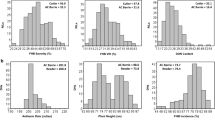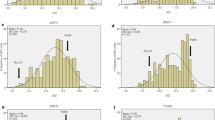Abstract
Main conclusion
Three known sugarcane aphid-resistant pollinator parents were sterilized in A3 cytoplasmic male sterility and were confirmed in this study to be resistant to sugarcane aphid allowing for the development of sugarcane aphid-resistant forage hybrids.
Abstract
We utilized A3 cytoplasmic male sterility and converted known sugarcane aphid-resistant sorghum TX 2783, and newly released R. LBK1 (Reg. No. GP-865, PI 687244) and R. LBK2 (Reg. No. GP-866, PI 687245) into A3 sterility to determine if the sterile counterparts would also equally express tolerance and or antibiosis to sugarcane aphid. Free-choice flat screen trials and life-table demographic studies were utilized and compared to know susceptible/fertile entries KS 585, and TX 7000, and known resistant/fertile entries TX 2783 and DKS 37-07. The R. LBK1 fertile entry was more tolerant than the known susceptible entries KS 585 and TX 7000, but was not as resistant as the other resistant entries, sustaining a damage rating of 6.0 across two different screen trials. The sterile A3 R. LBK2 showed a greater tolerance and expressed higher levels of antibiosis during aphid reproductive studies when compared to the known resistant and fertile TX 2783. All other fertile (R. LBK2, TX2783) and the A3 male sterile counterparts (A3 R. LBK2, A3 TX2783) were very similar in expression of high levels of tolerance and exhibited statistically similar damage ratings of 3.3–4.3 when exposed to sugarcane aphids. No entry, either fertile or sterile, was as tolerant as DKS 37-07, a known resistant commercial hybrid. Other plant measurements including percent loss in chlorophyll content, difference in plant height, and number of true leaves for sugarcane aphid infested versus non-infested were very consistent and highly correlated with damage ratings. Antibiosis was also exhibited in both fertile and sterile versions of the resistant lines. There was a 2 × reduction in fecundity between the R. LBK1 fertile and its sterile A3 R. LBK1 when compared to the susceptible KS 585 and TX 7000; however, the remaining fertile and sterile entries had 3.8 × to 5.8 × decrease in fecundity when compared to the susceptible KS 585 and TX 7000. Other measurements in life-table statistics such as nymphs produced/female/d, and the intrinsic rates of increased were significantly lower for all fertile and sterile lines, showing that antibiosis significantly affected sugarcane aphid reproduction. In conclusion, the A3 cytoplasmic male sterility shows consistency for maintaining the single dominant trait SCA-resistant trait of TX 2783 for expressing both antibiosis and tolerance, and great utility in the development of sugarcane aphid-resistant forage sorghums.
Similar content being viewed by others
Data availability statement
All data from this particular study will be made available upon reasonable request.
Abbreviations
- SoSCA:
-
Preferred sorghum biotype of the sugarcane aphid
- SuSCA:
-
Preferred sugarcane biotype of the sugarcane aphid
References
Anjali M, Sridevi G, Prabhakar M, Pushpavathi B, Laxmi N (2017) Dynamic changes in carotenoid and flavonoid content and relative water content (RWC) by corn leaf aphid infestation on sorghum. J Pharmacol Phytochem 6(5):1240–1245
Armstrong JS, Rooney WL, Peterson GC, Villenueva RT, Brewer MJ, Sekula-Ortiz D (2015) Sugarcane aphid (Hemiptera: Aphididae): host range and sorghum resistance including cross-resistance from greenbug sources. J Econ Entomol 108:576–582
Armstrong JS, Mbulwe L, Sekula-Ortiz D, Villanueva RT, Rooney WL (2017) Resistance to Melanaphis sacchari (Hemiptera: Aphididae) in forage and grain sorghums. J Econ Entomol 110:259–265
Armstrong JS, Paudyal S, Limaje A, Elliott N, Hoback W (2018) Plant resistance in sorghums to the sugarcane aphid Melanaphis sacchari (Hemiptera: Aphididae). J of Entomol Sci 53(4):478–485
Backoulou G, Elliot N, Giles K, Alves T, Brewer MJ, Starek M (2018) Using multispectral imagery to map spatially variable sugarcane aphid infestation in sorghum. Southw Entomol 43:37–44
Bayoumy MH, Perumal R, Michaud JP (2016) Comparative life histories of greenbugs and sugarcane aphids (Hemiptera: Aphididae) co-infesting susceptible and resistant sorghums. J Econ Entomol 109:385–391. https://doi.org/10.1093/jee/tov271
Bean BW, Baumhardt RL, McCollum FT III, McCuistion KC (2013) Comparison of sorghum classes for grain and forage yield forage nutritive value. Field Crop Res 142:20–26
Bowling R, Brewer MJ, Kerns D, Gordy J, Seiter N, Elliott N, Buntin D, Way M, Royer T, Biles S, Maxson E (2016) Sugarcane aphid (Hemiptera: Aphididae): a new pest on sorghum in North America. J Integr Pest Manag 7(1):1–13
Burd JD, Burton RL, Webster JA (1993) Evaluation of Russian wheat aphid (Homoptera: Aphididae) damage on resistant and susceptible hosts with comparisons of damage ratings to quantitative plant measurements. J Econ Entomol 86:974–980
De Souza M, Armstrong JS, Hoback W, Mulder P, Paudyal S, Foster J, Payton M, Akosa J (2019) Temperature dependent development of sugarcane aphids Melanaphis Sacchari, (Hemiptera: Aphididae) on three different host plants with estimates of the lower and upper threshold for fecundity. Curr Trends Entomol Zool Stud 2:1011
Denmark H (1988) Sugarcane aphids in Florida. Florida Department of Agriculture and Consumer Services, Division of Plant Industry. Entomology Circular, p 302
Elliott NC, Brewer MJ, Seiter N, Royer T, Bowling R, Backoulou G, Gordy J, Giles K, Lindenmayer J, McCornack B, Kerns D (2017) Sugarcane aphid spatial distribution in grain sorghum fields. Southw Entomol 42:27–35
Gonzales JD, Kerns DL, Brown SA, Beuzelin JM (2019) Evaluation of commercial sorghum hybrids for resistance to sugarcane aphid, Melanaphis sacchari (Zehntner). Southw Entomol 44:839–851
Hall DG (1987) The sugarcane aphid, Melanaphis sacchari, in Florida sugarcane. J Am Soc Sugar Cane Techn 7:26–29
Harris-Schultz KR, Brewer MJ, Wadl PA, Ni X, Wang H (2021) A sugarcane aphid “super clone” predominates on sorghum and Johnsongrass from four US states. J Entomol Sci 56(1):43–51
Hayes CM, Armstrong JS, Limaje A, Emendack YE, Burke JJ (2018) Registration of R. LBK1 and R. LBK2 sorghum germplasm with tolerance to the sugarcane aphid [Melanaphis sacchari (Zehntner)]. J Plant Regist 13(1):91
Hoffmann L Jr, Rooney W (2013) Cytoplasm has no effect on the yield and quality of biomass sorghum hybrids. J Sustain Bioenergy Syst 3:129–134. https://doi.org/10.4236/jsbs.2013.32018
Howad W, Tang HV, Pring DR, Kempken F (1999) Nuclear genes from Tx CMS maintainer lines are unable to maintain atp6 RNA editing in any anther cell-type in the Sorghum bicolor A3 cytoplasm. Curr Genet 36:62–68
SAS Institute (2016) SAS users guide, version 9.4. SAS Institute, Cary
Kerns DL, Brown S, Beuzelin J, Guidry KM (2015) Sugarcane aphid: a new invasive pest of sorghum. La Agric 58:12–14
Limaje A, Armstrong JS, Hoback W, Zarrabi A, Hayes C, Paudyal S, Burke J (2018) Antibiosis and tolerance discovered in USDA-ARS sorghums resistant to sugarcane aphid Melanaphis sacchari (Hemiptera: Aphididae). J Entomol Sci 53:230–241
Markwell J, Osterman JC, Mitchell JL (1995) Calibration of the Minolta SPAD-502 leaf chlorophyll meter. Photosynth Res 46:467–472
Maw M, Houx J, Fritsch F (2017) Maize, sweet sorghum, and high biomass sorghum ethanol yield comparison on marginal soils in Midwest USA. Biomass Bioenergy 107:154–171
Mbulwe L, Peterson GC, Armstrong JS, Rooney WL (2016) Registration of sorghum germplasm Tx3408 and Tx3409 with tolerance to sugarcane aphid [Melanaphis sacchari (Zehntner)]. J Plant Regist 10:51–56
Mercer D, Rennie T, Tubeileh A (2011) Drying studies of sorghum for forage and biomass production. Prod Food Sci 1:655–661
Miron J, Zuckerman E, Adin G, Nikbachat M, Yosef E, Zenou A, Weinberg Z, Solomn R, Ben-Ghedalia D (2007) Field yield ensiling properties and digestibility by sheep of silages from two forage sorghum varieties. Sci Direct Anim Feed Sci Technol 136:203–215
Mundia CW, Secchi S, Akamani K, Wang G (2019) A regional comparison of factors affecting global sorghum production: the case of North America, Asia and Africa’s Sahel. Sustainability 11(7):2135. https://doi.org/10.3390/su11072135
Paudyal S, Armstrong JS, Giles KL, Payton M, Opit G, Limaje A (2018) Categories of resistance to sugarcane aphid (Hemiptera: Aphididae) among sorghum genotypes. J Econ Entomol 112(4):798–804
Paudyal S, Armstrong JS, Harris-Shultz KR, Wang H, Giles KL, Rott PC, Payton ME (2019) Evidence of host plant specialization among the U.S. sugarcane aphid (Hemiptera: Aphididae) genotypes. Trends Entomol 15:47–58
Paudyal S, Armstrong JS, Giles KL, Hoback W, Aiken R, Payton ME (2020) Differential responses of sorghum genotypes to sugarcane aphid feeding. Planta 252:14
Pederson JF, Toy JJ (1997) Forage yield quality and fertility of sorghum x Sudan grass hybrids in A1 and A3 cytoplasm. Crop Sci 37:1973–1975
Peterson GC, Johnson JW, Teetes GL, Rosenow DT (1984) Registration of Tx 2783 greenbug resistant sorghum germplasm line. Crop Sci 24:390. https://doi.org/10.2135/cropsci1984.0011183X002400020062x
Peterson GC, Armstrong JS, Pendleton BB, Stelter M (2018) Registration of Tx3410 through Tx3428 sorghum germplasm resistant to sugarcane aphid [Melanaphis sacchari (Zehntner)]. J Plant Regist 12(3):391–398
Research Randomizer (2020). http://www.randomizer.org
Rooney WL, Odvody GN, Schaefer K, Collins SD (2011) Registration of TX2929 through 2934 sorghum germplasm. J Plant Regist 5:123–127
Rott P, Mirkov TE, Schenck S, Girard J (2008) Recent advances in research on sugarcane yellow leaf virus, the causal agent of sugarcane yellow leaf. Sugar Cane Int 26:18–27
Smith CM (2005) Plant resistance to arthropods—molecular and conventional approaches. Springer, Dordrecht
Starks KJ, Burton RL (1977) Greenbugs: determining biotypes, culturing, and screening for plant resistance with notes on rearing parasitoids. USDA Tech. Bull. 1556
Wang F, Zhao S, Han Y, Shao Y, Dong Z, Gao Y, Zhang K, Liu X, Li D, Chang J, Wang D (2013) Efficient and fine mapping of RMES1 conferring resistance to sorghum aphid Melanaphis sacchari. Mol Breed 31:777–784
White WH, Reagan TE, Hall DG (2001) Melanaphis sacchari (Homoptera: Aphididae), a sugarcane pest new to Louisiana. Fla Entomol 84:435–436
Worstell JV, Kidd HJ, Shertz KF (1984) Relationships among male-sterile inducing cytoplasms of sorghum. Crop Sci 24:186–189
Wyatt IJ, White PF (1977) Simple method for intrinsic increases for aphid and tetranychid mites. J Appl Ecol 14:757–766
Acknowledgements
We thank B. Driskel, H. Baker, C. Edwards, and M. Nesbitt for excellent technical support. The USDA is an equal opportunity provider and employer. The use of trade, firm, or corporation names in this publication is for the information and convenience of the reader. Such use does not constitute an official endorsement or approval by the United States Department of Agriculture or the Agricultural Research Service of any product or service to the exclusion of others that may be suitable. This research was partially funded by cooperative project 58-3072-6-015 between the USDA-ARS and Oklahoma State University, by the Department of Entomology and Plant Pathology at Oklahoma State University and supported by Hatch Project accession no. 1019561 from the USDA National Institute of Food and Agriculture. This research was also partially funded by the Kansas Grain Sorghum Commission.
Author information
Authors and Affiliations
Corresponding author
Additional information
Communicated by Anastasios Melis.
Publisher's Note
Springer Nature remains neutral with regard to jurisdictional claims in published maps and institutional affiliations.
Rights and permissions
About this article
Cite this article
Carey, C., Armstrong, J.S., Hayes, C. et al. Evaluation of A3 cytoplasmic male sterile forage sorghum lines for resistance to sugarcane aphid. Planta 255, 38 (2022). https://doi.org/10.1007/s00425-022-03820-7
Received:
Accepted:
Published:
DOI: https://doi.org/10.1007/s00425-022-03820-7




